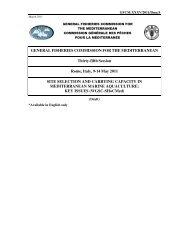Status of alien species in the Mediterranean and Black Sea
Status of alien species in the Mediterranean and Black Sea
Status of alien species in the Mediterranean and Black Sea
Create successful ePaper yourself
Turn your PDF publications into a flip-book with our unique Google optimized e-Paper software.
54<br />
<strong>Mediterranean</strong> coast. Schembri et al. (2010) reported that C. <strong>and</strong>romeda was observed <strong>of</strong>f <strong>the</strong> Maltese<br />
isl<strong>and</strong>s <strong>in</strong> <strong>the</strong> Central <strong>Mediterranean</strong> <strong>Sea</strong>.<br />
4.3 Impacts on fisheries<br />
Mostly <strong>in</strong> <strong>the</strong> eastern <strong>Mediterranean</strong> <strong>Sea</strong>, several <strong>alien</strong> <strong>species</strong> cause damages to fisheries. Caulerpa<br />
taxifolia cause considerable foul<strong>in</strong>g on fish<strong>in</strong>g nets. Cal<strong>in</strong>ectes sapidus also damages nets with<br />
entangl<strong>in</strong>g <strong>and</strong> cutt<strong>in</strong>g. In Turkey <strong>and</strong> Cyprus, fishers compla<strong>in</strong> about L. scelaratus because <strong>the</strong>y cut<br />
hooks <strong>of</strong> longl<strong>in</strong>es <strong>and</strong> bite <strong>of</strong>f <strong>the</strong> captured fish <strong>in</strong> <strong>the</strong> nets or on <strong>the</strong> l<strong>in</strong>es, which has a negative<br />
economical impact on fishers <strong>of</strong> Israel <strong>and</strong> blocked gill-nett<strong>in</strong>g for several weeks (Spanier <strong>and</strong> Galil,<br />
1991). Kideys <strong>and</strong> Gücü (1995) <strong>and</strong> Avşar (1999) reported that <strong>the</strong> proliferation <strong>of</strong> R. nomadica <strong>of</strong>f<br />
<strong>the</strong> eastern <strong>Mediterranean</strong> coast <strong>of</strong> Turkey has a potential risk to human health, tourism <strong>and</strong> fisheries.<br />
In August 1995, many swimmers were stung <strong>and</strong> sought medical treatment. Local fishers claimed that<br />
<strong>the</strong> catch from <strong>the</strong> gill net fisheries decreased <strong>and</strong> that <strong>the</strong> jellyfish entangled <strong>in</strong> <strong>the</strong>ir nets were a major<br />
nuisance. In Iskenderun, due to mass jellyfish blooms, <strong>the</strong> fish farmers could not lift <strong>the</strong>ir nets to <strong>the</strong><br />
surface when <strong>the</strong>y wanted to take <strong>the</strong> fish from <strong>the</strong> cages. R. nomadica do not move actively, thus<br />
penetrates <strong>the</strong> Levant <strong>Sea</strong> like o<strong>the</strong>r lessepsian <strong>species</strong>’ spread pattern, follow<strong>in</strong>g <strong>the</strong> Levant<strong>in</strong>e current<br />
system. Avşar (1999) also reported that firstly <strong>the</strong>y reached Lebanon <strong>and</strong> Syrian Arab Republic, <strong>the</strong>n<br />
<strong>the</strong> Turkish eastern <strong>Mediterranean</strong> coasts, cl<strong>in</strong>g<strong>in</strong>g to fish<strong>in</strong>g nets <strong>and</strong> caus<strong>in</strong>g economic damages.<br />
Impacts <strong>of</strong> <strong>the</strong> <strong>alien</strong> <strong>species</strong> should be considered also for <strong>the</strong> fisheries management, because <strong>the</strong><br />
traditional mesh size <strong>of</strong> <strong>the</strong> fish<strong>in</strong>g nets may need to be changed due to new commercial <strong>species</strong><br />
mostly <strong>in</strong> <strong>the</strong> eastern <strong>Mediterranean</strong> countries. This <strong>in</strong>volves extra costs for fishers or fish<strong>in</strong>g<br />
communities, which were difficult for traditional fishers who have limited f<strong>in</strong>ancial source. Ano<strong>the</strong>r<br />
issue is that fish <strong>in</strong>spectors can easily confuse native <strong>and</strong> <strong>alien</strong> fishes when <strong>the</strong>y exam<strong>in</strong>e control <strong>the</strong><br />
size limitation <strong>of</strong> <strong>the</strong> fish on <strong>the</strong> deck <strong>of</strong> fish<strong>in</strong>g boats, e.g. native mullet Mullus barbatus, Mullus<br />
surmelatus vs U. moluccensis. Some <strong>of</strong> <strong>the</strong> Turkish fishers compla<strong>in</strong> about discards <strong>of</strong> <strong>alien</strong> fish<br />
<strong>species</strong> such as Lagocephalus spp <strong>and</strong> F. commersonii which have no commercial value <strong>in</strong> <strong>the</strong><br />
<strong>Mediterranean</strong> part <strong>of</strong> Turkey.<br />
Some toxic algae give damage to fisheries due to contam<strong>in</strong>at<strong>in</strong>g filter-feed<strong>in</strong>g shellfish <strong>species</strong>. In<br />
some areas <strong>the</strong>y cause fisheries to be closed or partially closed. Consumption <strong>of</strong> <strong>the</strong> contam<strong>in</strong>ated<br />
shellfish can be dangerous for human health.<br />
4.4 Impacts on tourism, human health <strong>and</strong> o<strong>the</strong>r socio-economic activities<br />
Alien jellyfish <strong>species</strong> are also a threat for tourism. In fact some people had to be hospitalized after<br />
hav<strong>in</strong>g been <strong>in</strong> contact with <strong>the</strong>se <strong>species</strong> <strong>in</strong> <strong>the</strong> eastern <strong>Mediterranean</strong> <strong>Sea</strong> countries. Jellyfish can be<br />
dangerous <strong>in</strong> case <strong>of</strong> allergy. The most important factor is <strong>the</strong> amount <strong>of</strong> poison put <strong>in</strong>to blood. Death<br />
rarely occurs, but m<strong>in</strong>or effects can be observed. These can be itch<strong>in</strong>g, severe poison<strong>in</strong>g, muscle<br />
cramps, abdom<strong>in</strong>al rigidity, decrease <strong>in</strong> touch sensation, nausea, vomit<strong>in</strong>g, serious back pa<strong>in</strong>, speech<br />
difficulties, <strong>in</strong>voluntary muscle contractions <strong>and</strong> breath<strong>in</strong>g difficulty (Mariott<strong>in</strong>i et al., 2008).<br />
Certa<strong>in</strong>ly venomous jellyfish have a negative impact on tourism (Spanier <strong>and</strong> Galil, 1991). Table 4.3<br />
summarizes <strong>the</strong> impacts <strong>of</strong> <strong>alien</strong> <strong>species</strong> on tourism <strong>and</strong> human health ei<strong>the</strong>r by st<strong>in</strong>g<strong>in</strong>g or by be<strong>in</strong>g<br />
eaten. In 2009, several blooms <strong>of</strong> Rhopilema nomadica were reported <strong>and</strong> some people were<br />
hospitalized <strong>in</strong> Antalya, Mers<strong>in</strong>, Iskenderun <strong>and</strong> Adana Prov<strong>in</strong>ces <strong>in</strong> <strong>the</strong> Turkish part <strong>of</strong> <strong>the</strong><br />
<strong>Mediterranean</strong> <strong>Sea</strong> (Öztürk <strong>and</strong> İş<strong>in</strong>ibilir, 2010). R. nomadica is also reported from Greece (Frangou-<br />
Siokou et al., 2006).
















